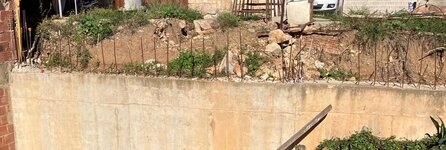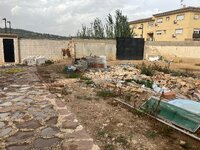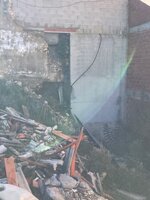highlander50
Geotechnical
- Oct 4, 2022
- 4
Dear Engineers,
I want to present a problem I’ve encountered in one of our projects.
We have a client planning to build a house on a plot of land. The plot is quite large, and he only intends to use half of it.
The area where the house is to be built is partially covered by an old swimming pool of unknown depth, filled with demolition and rubble materials, which prevents us from positioning any machine on it to work effectively. We also don’t know the exact shape of the pool in terms of depth-wise, whether the bottom is completely flat or if it slopes to one side.
On the other hand, this half of the plot is at the same level as Street 2 (see attached diagram) but sits at a higher elevation than the other half of the plot.
The other half of the plot was initially used to construct a 6 floor building, but due to financial issues, the builder left the project halfway through, with a concrete slab installed at a depth of 12 meters (as we’ve been informed) and some of the initial diaphragm walls in place for later enclosure. However, when the construction company went bankrupt, the site was left open, and it was later partially filled with anthropic backfill without any compaction or quality control.
The fill doesn’t occupy the entire “hole” left from the unfinished construction, resulting in a level difference of approximately 8 meters between the two halves of the plot.
The walls that retain the soil mass have had their reinforcement exposed to the air for at least 20 years, and in the area furthest from the planned construction site, they seem to be deteriorating based on their current condition.
As an additional note, I haven’t noticed any drainage elements in these walls, which were initially intended to house the parking structure of a building that was never completed.
At this point, I have several questions to correctly approach the problem, and I’d like to get your opinion on it.
Thank you very much in advance for your comments.
I want to present a problem I’ve encountered in one of our projects.
We have a client planning to build a house on a plot of land. The plot is quite large, and he only intends to use half of it.
The area where the house is to be built is partially covered by an old swimming pool of unknown depth, filled with demolition and rubble materials, which prevents us from positioning any machine on it to work effectively. We also don’t know the exact shape of the pool in terms of depth-wise, whether the bottom is completely flat or if it slopes to one side.
On the other hand, this half of the plot is at the same level as Street 2 (see attached diagram) but sits at a higher elevation than the other half of the plot.
The other half of the plot was initially used to construct a 6 floor building, but due to financial issues, the builder left the project halfway through, with a concrete slab installed at a depth of 12 meters (as we’ve been informed) and some of the initial diaphragm walls in place for later enclosure. However, when the construction company went bankrupt, the site was left open, and it was later partially filled with anthropic backfill without any compaction or quality control.
The fill doesn’t occupy the entire “hole” left from the unfinished construction, resulting in a level difference of approximately 8 meters between the two halves of the plot.
The walls that retain the soil mass have had their reinforcement exposed to the air for at least 20 years, and in the area furthest from the planned construction site, they seem to be deteriorating based on their current condition.
As an additional note, I haven’t noticed any drainage elements in these walls, which were initially intended to house the parking structure of a building that was never completed.
At this point, I have several questions to correctly approach the problem, and I’d like to get your opinion on it.
- The house will have its foundations at different levels. In areas without the pool, continuous footings are planned at a depth of about 1.00 meter. However, the foundation depth in the pool area is unknown until the debris is cleared. How would you approach this part?
- Given the foundation at different levels, with the deepest level currently unknown, I understand that differential settlement shouldn’t be an issue if we design based on the materials closer to the surface, as the materials below the pool should theoretically be more competent and likely overconsolidated (due to the weight of the water it once held). Do you think this assumption is valid?
- Regarding the pool, I’m uncertain how to face it. Without knowing the foundation depth, it’s challenging to suggest that the pool should be supported by a semi-deep foundation, but I’d like to hear your thoughts.
- We have a diaphragm wall, apparently without drainage, with exposed reinforcement for 20 years, an 8-meter elevation difference, and now a house will be added on top, increasing the soil pressure against it. My inclination is to investigate this wall's dimensions to ensure it can withstand the load over time, but I’d like to know your opinion as well if you consider that can be an issue.
Thank you very much in advance for your comments.




